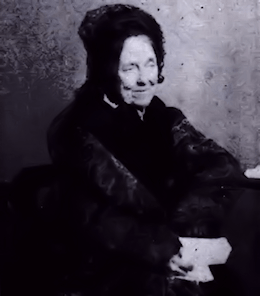Textus Receptus Bibles
Julia E. Smith Translation 1876
| 1:1 | The book of the generation of Jesus Christ, son of David, son of Abraham. |
| 1:2 | Abraham begat Isaac; and Isaac begat Jacob: and Jacob begat Judas and his brethren; |
| 1:3 | And Judas begat Phares and Zara of Thamar; and Phares begat Esrom; and Esrom begat Aram; |
| 1:4 | And Aram begat Aminadab; and Aminadab begat Naasson; and Naasson begat Salmon; |
| 1:5 | And Salmon begat Booz of Rachab; and Booz begat Obed of Rath; and Obed begat Jesse; |
| 1:6 | And Jesse begat David the king; and David the king begat Solomon of her of Urias |
| 1:7 | And Solomon begat Roboam; and Roboam begat Abia; and Abia begat Asa; |
| 1:8 | And Asa begat Josaphat; and Josaphat begat Joram; and Joram begat Ozias; |
| 1:9 | And Ozias begat Joatham; and Joatham begat Achaz; and Achaz; begat Ezekias; |
| 1:10 | And Ezekias begat Manasses; and Manasses begat Amon; and Amon begat Josias; |
| 1:11 | And Josias begat Jeehonias and his brethren upon the transferring of Babylon |
| 1:12 | And after the transferring of Babylon Jechonias begat Salathiel; and Salathiel begat Zorobabel; |
| 1:13 | And Zorobabel begat Abiud; and Abiud begat Eliakim; and Eliakim begat Azor; |
| 1:14 | And Azor begat Sadoc; and Sadoc begat Achim; and Achim beget Elind; |
| 1:15 | And Elind begat Eleazar; and Eleazar begat Matthan; and Matthan begat Jacob; |
| 1:16 | And Jacob begat Joseph the husband of Mary, of whom was born Jesus, being called Christ, the anointed. |
| 1:17 | Therefore all the generations from Abraham to David, fourteen generations; and from David to the transferring of Babylon, fourteen generations; and from the transferring of Babylon to Christ, fourteen generations. |
| 1:18 | And the generation of Jesus Christ was thus: for Mary his mother having been betrothed to Joseph, before they came together she was found with child by the Holy Ghost. |
| 1:19 | And Joseph her husband being just, and not willing to expose her to disgrace, wished to let her go in secret. |
| 1:20 | And reflecting upon these things, behold a messenger of the Lord appeared to him saying, Joseph, thou son of David, thou shouldest not fear to take to thyself Mary thy wife: for that begotten in her is of the Holy Spirit. |
| 1:21 | And she shall bring forth a son, and thou shalt call his name Jesus; for he shall save his people from their sins, |
| 1:22 | And the whole of this has been that it might be completed having been spoken by the prophet, saying, |
| 1:23 | Behold, the virgin shall be with child, and shall bring forth a son, and they shall call his name Emmanuel, which is, being interpreted, God with us. |
| 1:24 | And Joseph having awaked from sleep, did as the messenger of the Lord commanded him: |
| 1:25 | And he took to himself his wife, and knew her not till she brought forth her first born son: and be called his name Jesus. |

Julia E. Smith Translation 1876
The Julia Evelina Smith Parker Translation is considered the first complete translation of the Bible into English by a woman. The Bible was titled The Holy Bible: Containing the Old and New Testaments; Translated Literally from the Original Tongues, and was published in 1876.
Julia Smith, of Glastonbury, Connecticut had a working knowledge of Latin, Greek and Hebrew. Her father had been a Congregationalist minister before he became a lawyer. Having read the Bible in its original languages, she set about creating her own translation, which she completed in 1855, after a number of drafts. The work is a strictly literal rendering, always translating a Greek or Hebrew word with the same word wherever possible. Smith accomplished this work on her own in the span of eight years (1847 to 1855). She had sought out no help in the venture, even writing, "I do not see that anybody can know more about it than I do." Smith's insistence on complete literalness, plus an effort to translate each original word with the same English word, combined with an odd notion of Hebrew tenses (often translating the Hebrew imperfect tense with the English future) results in a translation that is mechanical and often nonsensical. However, such a translation if overly literal might be valuable to consult in checking the meaning of some individual verse. One notable feature of this translation was the prominent use of the Divine Name, Jehovah, throughout the Old Testament of this Bible version.
In 1876, at 84 years of age some 21 years after completing her work, she finally sought publication. The publication costs ($4,000) were personally funded by Julia and her sister Abby Smith. The 1,000 copies printed were offered for $2.50 each, but her household auction in 1884 sold about 50 remaining copies.
The translation fell into obscurity as it was for the most part too literal and lacked any flow. For example, Jer. 22:23 was given as follows: "Thou dwelling in Lebanon, building as nest in the cedars, how being compassionated in pangs coming to thee the pain as in her bringing forth." However, the translation was the only Contemporary English translation out of the original languages available to English readers until the publication of The British Revised Version in 1881-1894.(The New testament was published in 1881, the Old in 1884, and the Apocrypha in 1894.) This makes it an invaluable Bible for its period.